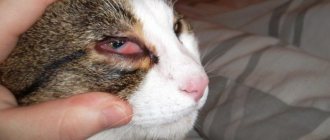Every day, more than one thousand operations to castrate domestic cats are performed in all veterinary clinics. The significance of the procedure is difficult to overestimate, since with its help it is possible to curb the increase in the number of stray animals. The operation itself is quite simple and is often performed at home. But the simplicity of the procedure does not exclude a certain probability of complications. It happens, for example, that a cat bleeds after surgery. What does this mean and should I seek help from a veterinarian?
General information
Let's make a small digression right away. Keep in mind that after a normally performed castration nothing should bleed!!!
In a healthy cat that does not have any pathologies of the blood coagulation system, the primary healing of the postoperative wound begins immediately. Moreover, the scope of surgical intervention during castration is extremely small. In fact, only the skin of the scrotal sac (scrotum) is cut, where there are simply no large blood vessels. The capillaries in this area are instantly blocked by blood clots. Even during the operation itself, very little blood is released. Please note that during the first hour and a half after the procedure, a small amount of bloody fluid (ichor) is allowed to be released, but not pure blood!
But! In cases where your cat is cryptorchid , infertility was carried out through abdominal surgery (the testes in such situations are located in the abdominal cavity), everything is somewhat different.
When a stitch bleeds after castration, there is nothing “supernatural” about this phenomenon. The release of a small amount of it does not threaten the animal with anything serious. This is only true in situations where the bleeding is really minor and continues for a maximum of three days from the moment of surgery.
In addition, it should not be accompanied by redness and swelling of the surgical area, as well as an increase in local body temperature. All these signs indicate the development of an inflammatory process, potentially dangerous to the life and health of the cat.
So the situation when a cat’s wound bleeds after deprivation does not bode well for your pet.
In any case, you will need to contact your veterinarian immediately. The sooner you do this, the better. Otherwise, he may well die from internal bleeding.
Possible complications during castration of cats.
© Dr. Shauna O'Meara
Castration of cats may be accompanied by some complications that arise both during the operation itself and after its completion. It doesn’t hurt to know about possible problems so that you can take them into account when deciding whether to castrate your cat. It is important to understand that almost all of the complications listed below are extremely rare, and the risk of their occurrence does not outweigh the benefits of neutering your pet. The most common complications, in the vast majority of cases, are not life-threatening for the cat, and, moreover, as a rule, can be prevented with careful and careful care of the cat in the postoperative period.
Pain after castration. One of the most common complications, although cats usually do not show any signs of noticeable pain or discomfort immediately after surgery. The reasons for the pain are quite obvious - the surgery is performed on a very delicate part of the cat’s body.
>>
Tumors, bruises, filling of the scrotum with blood. A common complication. It is not uncommon for a cat to be brought home after surgery with noticeable swelling, bruising and blood in the scrotum.
>>
Suture infection. Not a very common complication. Perhaps in cases where bacteria gain access to wounds at the site of surgical sutures and multiply there in large numbers. A bacterial infection causes damage to body tissue at the site of the lesion, which prevents normal healing and triggers an attack by the secondary immune system on the damaged area, causing inflammation (redness, swelling, fever) and suppuration (white blood cells producing yellow or green discharge).
>>
Damage to the penis and/or urethra. Occurs extremely rarely, due to surgeon errors. In cats, the testicles and penis are anatomically located very close to each other. Therefore, for an inexperienced veterinarian, it is theoretically possible (in practice - extremely rare) to make an incision in the penis and (or) urethra if the surgeon cuts too deep or in the wrong place during the operation.
>>
Excessive bleeding during or after a cat is neutered. Rarely observed. A little bleeding from the wound in neutered cats is considered normal—a small amount of blood may usually ooze along the cut line. This usually occurs within an hour or so, in the form of a few drops, and there is no bleeding as such. It very rarely happens that after surgery a cat experiences increased bleeding at the incision sites.
>>
Unsuccessful ligation of testicular blood vessels. Rarely observed. The sperm ducts and blood vessels of each cat's testicle exit from the depths of the animal's abdominal cavity through natural openings in its wall (inguinal canals or inguinal rings) into the groin area on each side (left and right). During castration, these canals are ligated. If the ligation is done incorrectly, the ducts go into the cat's abdominal cavity and hemorrhage begins there. In this case, in order to save the cat, it is necessary to open the abdominal cavity, find the bleeding vessel and tie it off.
>>
Kidney failure. Rarely observed in young healthy cats. Although modern anesthetic drugs are much less suppressive of the cardiovascular system and have less impact on the kidneys and liver, there is still a possibility that a particular cat or kitten may develop acute renal failure. This may occur immediately after or several days after anesthesia, although castration is a routine and quick operation.
>>
Death during anesthesia. Happens extremely rarely. However, almost every veterinarian encounters in his practice a case where a young healthy cat dies for an inexplicable reason during a completely ordinary operation.
>>
Damage to the trachea due to swelling of the endotracheal tube. It is observed very rarely. Possibly when the cuff of the tube inserted into the throat becomes too full. In this case, this can lead to damage to the mucous membrane of the cat's trachea.
>>
This is interesting: How long does it take for a cat to recover from anesthesia?
Poor ligature application
You need to understand what exactly happens during the operation.
- The veterinarian cuts the skin of the scrotum.
- Cuts the testicular ligament.
- Places a clamp and ligature on the cord formed by the vas deferens and blood vessels.
The latter enter the abdominal cavity through an opening called the inguinal ring. The life of the animal depends on the quality of the ligature over which the testis is cut off. If the suture material was placed carelessly, or the thread used for the dressing was of poor quality, the knot will almost inevitably become loose. The worst thing is that the stump of the cord after the operation goes into the abdominal cavity...
What will happen as a result? Nothing good - massive bleeding will develop , as a result of which the entire abdominal cavity can turn into a container for blood. The only way to save the cat is immediate abdominal surgery. During this process, it is necessary to urgently find the “escaped” vessels and re-bandage them. There are cases where animals died within half an hour, when the owners had just managed to pick them up from the veterinarian.
Not in all cases, a poor-quality ligature is to blame. Practitioners believe that approximately 0.5-1.5% of all cats have pathologies of the blood coagulation system (for example, thrombocytopenia of various etiologies). If they are not identified in time and surgery is performed, the cat may die from massive hemorrhage, even if the castration itself was performed perfectly.
Please note! Poor blood clotting cannot be detected by eye. It is in order to identify such pathologies that it is necessary to conduct a full medical examination of the animal at the stage of preparation for castration.
Diagnosis of the condition
If your cat is peeing blood, then the first thing to do is contact a veterinary clinic in Moscow. Here, specialists will conduct an initial examination and take urine for laboratory tests.
In order to more fully and accurately diagnose your pet’s condition, the following may be prescribed:
- blood chemistry,
- vaginal smear,
- x-ray of the abdominal organs,
- histological examination,
- cytoscopy.
Having made a diagnosis, the veterinarian prescribes an effective treatment program and determines how to treat your pet.
Damage to the penis
The genital organs (i.e. penis and scrotum) are anatomically very close to each other. Therefore, if castration is performed carelessly (as well as in cases where the cat is poorly fixed and “jerks” a lot), the possibility of damage to the urethral canal cannot be ruled out. Such cases are very rare, but they still happen. And the cat in such a situation faces not only the need for additional surgery, but also a very long recovery period.
Any damage to the penis, which consists of large cavernous bodies, always leads to intense bleeding. It is often so intense that the animal dies from severe blood loss within a few minutes.
Moreover, even with successful relief of hemorrhage, it happens that the tissues of the penis, which are very demanding of nutrition and oxygen, partially die, and processes of necrotic decay develop in them. To prevent an animal from becoming a “eunuch” in the full sense of the word, a complex and very expensive operation for plastic surgery of the penis is required. And, by the way, not every veterinary surgeon will undertake to perform it.
Foreign veterinary periodicals describe cases where, as a result of damage to the penis, veterinarians had to “feminize” a cat, making his penis something like a female vulva. This is easier than forming a new sexual organ.
Clinical manifestations of bleeding
Bleeding after castration can be venous, arterial (from arteries, veins of the scrotum, artery of the spermatic cord, pampiniform plexus, testicular arteries, vas deferens arteries), as well as primary and secondary.
Primary is noted during surgery, secondary – several hours or days after the procedure. There is also a distinction between external and internal bleeding. External is diagnosed by external manifestations, internal - by symptoms of anemia.
When veins are damaged, the blood has a dark color and viscous consistency. When the arteries are damaged, the blood has a bright scarlet color and is released in droplets, a thin weak or strong stream. In this case, the pressure of the jet changes depending on the position of the cat’s body. For example, bleeding increases if the cat gets up and is active, and decreases during sleep.
Important! The most dangerous to the life and health of animals is venous bleeding from the vessels of the spermatic cord, internal bleeding into the peritoneum.
Severe internal or external bleeding leads to the development of anemia, which can be understood by the pale color of the mucous membranes. The animals are weakened, sleep most of the day, try to hide in dark places, are reluctant to react to stimuli, and refuse their favorite treats and food. The temperature may be increased by one or two degrees or decreased. In acute bleeding, breathing becomes rapid and the heart rhythm is disturbed.
If your cat is bleeding from a stitch, there is noticeable heavy bleeding upon arrival home, or bleeding from the wound starts a few days later, immediately take your pet to the veterinary clinic. Otherwise, the cat will lose a lot of blood, which will lead to the development of severe complications. If help is not provided in time, the pet will die from severe blood loss.
This is interesting: The cat stopped going to the toilet after castration
Of course there shouldn't be any blood...
our home PHARAOH lives here
«Previous topic|Next topic»
Related topics
After castration...
from shoppi in the Health section
Answers: 36
Last message: 08/29/2018, 19:17
washing after castration
from ckler in the Health section
Answers: 17
Last message: 02/01/2015, 23:24
problems after castration!!!
from kitti in the Health section
Replies: 10
Last message: 11/13/2014, 5:39 pm
Cat after castration.
from Denezhka in the Health section
Answers: 8
Last message: 07/14/2014, 21:33
Damage to the urethral canal
In even rarer cases, castration may be complicated by damage to the urethra. In the urethra itself, of course, there are not many large blood vessels, but the available quantity is enough for the development of clearly visible bleeding. In particular, blood will constantly appear in the urine of such a pet.
In severe cases, urine will look like tomato juice . The most severe situations are characterized by gradual leakage of urine from the damaged urethra into the surrounding tissues of the penis. Since urine is a liquid that is very caustic from a chemical point of view, everything ends in severe necrosis of the penis. This often leads to the need for surgical amputation, as a result of which the cat becomes disabled.
The most unpleasant thing is that the owners sometimes don’t notice anything for a long time . In such cases, blood is released briefly and in small volumes. It, being mixed with urine, accumulates in the cavernous bodies of the penis and begins to rot there. Within about two days, the penis swells greatly, turns red, and becomes very painful. As in the previous case, this pathology requires immediate hospitalization of the cat and additional surgery. There is nothing you can do about this at home.
Conclusion. What should you do if a recently operated cat is bleeding from somewhere in the genital area? Contact a veterinarian immediately! This is the only way you can protect the health and life of your pet.
Bleeding in cats after castration
If the veterinary surgeon performed the operation competently and qualifiedly, there should be no blood when performing castration using a closed method. Drip discharge of ichor from the place where the incision was made, slight inflammation of the dissected tissues is acceptable. The natural healing process lasts 24-72 hours . May be accompanied by general weakness, depression, inadequate response to stimuli, drowsiness, decreased appetite, refusal to eat, increased thirst, and a slight increase in temperature.
If a cat’s wound is bleeding immediately after surgery, this means that the ligature on the testicular cord is loosely tightened; the veterinarian loosely tied the biological knot. As a rule, if the surgeon made a mistake, if there is severe bleeding, the surgeon must take measures to eliminate complications even before the cat wakes up after anesthesia.
Causes of bleeding after castration:
- improper care, unsanitary conditions;
- physician errors when performing castration of males (damage to the penis, large vessels, veins, arteries);
- seam divergence;
- short stump;
- sclerosis of the scrotal tissue;
- phlebeurysm;
- improper disconnection of transitional ligaments;
- poor blood clotting.
Severe postoperative bleeding often indicates that the cat has poor blood clotting (hemophilia, platelet deficiency, thrombocytopenia). In older, elderly animals, such a complication is often provoked by sagging tissue of the spermatic cord, and can also be caused by atherosclerosis of the blood vessels.
Let us note that a postoperative wound in a cat can bleed if the pet chews the stitches and constantly licks the incision site, which will invariably lead to the penetration of pathogenic flora into the wound opening and the development of acute inflammation.











